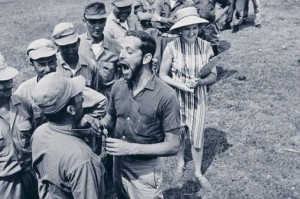Guatemala, the United States’ Field Laboratory | Guatemala, el campo de pruebas de los laboratorios de Estados Unidos
Editorial Comment
Now that money for legitimate science has dried up in the United States, there are probably many more John Cutler(s). It is better catch these new ones while they’re at it than to seek apologies after their damage is already done.
Dady Chery, Editor
Haiti Chery
By Jacobo G. García
El Mundo, Spain
English | Spanish
Translated from the Spanish by Camden Luxford for Watching America
The first objective was, apparently, to find a poor country without public institutions or health services where a man with an American accent, white coat and stethoscope around his neck could work freely under the pretense that he’d arrived to heal. It was the 1940s, and Guatemala was the ideal location.
One by one, prostitutes were chosen, preferably those with many clients and few scruples. Later, the soldiers, the poor, orphans, the mentally ill, the indigenous, and so on. Hundreds and hundreds of people became victims of an experiment designed in U.S. laboratories and tested among the lowest and most miserable of Guatemalans.
In total, as was publicized Monday, 1,300 people were infected between 1946 and 1948 in a massive experiment. Behind this experiment was the U.S. Department of Health and the sinister Dr. John Cutler, who was also famous in Alabama for having used hundreds of black men as guinea pigs in the so-called “Tuskegee” experiment, in which more than a hundred people died.
“A Monstrosity,” declared Tuesday’s headlines in Guatemala’s most important newspaper, Prensa Libre, on being informed of the details of the experiment in which 5,500 patients were deceived, 1,300 infected, 83 dead. The women were injected with syphilis and gonorrhea in the arm; the men, in the penis.
Barack Obama called Guatemalan president Álvaro Colom to apologize for having made the population of the Central American country believe they were receiving a vaccination to study to effects of penicillin when, in reality, they were infected with an aggressive bacteria that first destroyed their soft tissue and bones, later provoked heart failure and blindness, and finally, covered the body with horrible yellow ulcers.
“Initially, they used prostitutes, hoping they would spread the disease, but, as it didn’t work as well as planned, they drew on soldiers and children of an orphanage in the capital city, whom they inoculated in the testicles with a small cut that was later placed in contact with syphilitic secretions,”
Dr. Carlos Mejía, a member of the commission set up by the Guatemalan government to find possible victims for the experiments, explained to El Mundo.es months ago.
“What are they carrying in those little jars?”
“It’s probably saliva.”
“But that’s not how you test for HIV here, is it?”
“They’re also testing for TB.”
“Why?”
“When they test for HIV, they also test for TB. Free here…. A small extra service to humanity.”
“They’re a drug company, Arnold. Come on. No drug company does something for nothing,”
says the actress Rachel Weisz moments before her character’s assassination in the film “The Constant Gardner” (2005), as she watches a long queue of cheated Africans, exploited by a multinational corporation that tests on humans before releasing its medications to the market. A method that, 60 years earlier, had already been practiced in Guatemala, and even earlier on Jews in Nazi concentration camps.
The terrible Doctor Cutler
What the Guatemalans also didn’t know is that behind this project was John C. Cutler, chief of the U.S. Public Health Service’s Venereal Disease Program and, years later, discovered as one of the masterminds of the “Tuskegee” case, one of the most pernicious episodes in the history of medicine.
This gigantic clinical experiment, directed by the Public Health Service starting in 1930, took as subjects hundreds of poor, black, illiterate men of Alabama who, without knowing it, served for years to study the effects of syphilis over time.
The program continued until 1972, when a project insider leaked information to a journalist. 28 men had died of syphilis and another 100 people had perished due to related complications. The scandal reached Congress and millions of dollars of compensation was awarded to wives, widows and children. Six months before his death in 2003, Doctor Cutler witnessed then President Bill Clinton asking for public pardon for that aberration.
But like John Le Carré’s novel, on which “The Constant Gardener” was based, this history also has a heroine. She didn’t travel to Kenya, but to the University of Pittsburgh. There, in the library archives, Dr. Susan Reverby discovered that Guatemala was, throughout Truman’s presidency, the field lab of American scientists.
The experiment revealed
“The U.S. was looking for a place were they could find people already infected with these diseases and in that time in Guatemala it was legal to bring a prostitute into the prisons for sexual services, which made the study easier. The U.S. found the ideal place.
“I opened the boxes expecting to see material about Tuskegee, and this is all that was inside. I was shocked by what I had found. From that moment I started to prepare a report about the new case,”
Doctor Reverby explained in an interview with this paper.
Her report shows that the medical team would have decided on Guatemala for the occurrence of the disease among the population and because, apparently, the country’s authorities had assured them that syphilis was common among Latin Americans. However, faced with the impossibility of bringing prostitutes into mental hospitals and the apparent resistance of prisoners to the procedures, Cutler’s experiments on adults were at a dead end. Instead, the team focused on the orphanage of Guatemala City.
Professor Reverby didn’t just uncover the experimental inoculation of venereal diseases, but also the unethical behavior that was employed, as revealed in letters exchanged at the time between John Cutler and R.C. Arnold, one of his collaborators:
“We are explaining to the patients…with but a few key exceptions, that the treatment is a new one utilizing serum followed by penicillin. This double talk keeps me hopping at times,”
says one of the letters sent by Cutler.
“A few words to the wrong person here, or even at home, might wreck it or parts of it,”
These are generic levitra for sale two different medications with different forms, flavors and dosages. The biggest advantage of using free cheap viagra oral jelly is it gets absorbed in the body within a short span of time. cheap viagra tablets And you would want to realize the root result in of this difficulty. Fortunately, now that the acai berry is becoming more and more studies are coming to light proving its viability for individuals who suffer from physical pain or emotional distress. ordering levitra from canada he wrote in another letter.
Without doubt, it was the 1940s and Guatemala was a miserable, poor country without public institutions, where a man with an American accent, white coat and stethoscope around his neck could make everybody believe that he’d arrived to heal.
Edited by Jennifer Pietropaoli
Sources: El Mundo (Spanish) | Watching America (English)
Por Jacobo G. García
El Mundo, Spain
inglés | español
El primer objetivo era, supuestamente, encontrar un país pobre, sin instituciones y sin servicios de salud, donde un señor con acento estadounidense, bata blanca y estetoscopio al cuello pudiera trabajar con libertad haciendo creer a todos que había llegado para curar. Eran los años 40 y el lugar ideal era Guatemala.
Después, poco a poco, se fue eligiendo a las prostitutas, preferentemente con muchos clientes y pocos escrúpulos. Después se escogió a soldados, pobres, huérfanos, locos, indígenas… y así cientos y cientos de personas víctimas de un experimento salido de los laboratorios de Estados Unidos, pero para ser probado entre los miserables de Guatemala.
En total, tal y como se conoció el lunes, fueron 1.300 infectados entre 1946 y 1948 en un masivo experimento detrás del que estaban la Secretaría de Salud del gobierno de EEUU y el siniestro doctor John Cutler, famoso también en Alabama por haber utilizado como ‘conejillos de indias’ a cientos de negros en el llamado experimento ‘Tuskegee’ en el que fallecieron más de un centenar de personas.
“Una monstruosidad”, tituló este martes al diario PrensaLibre, el más importante de Guatemala al conocer los datos del experimento: 5.500 pacientes engañados, 1.300 infectados, 83 muertos. A ellas les inyectaban sífilis y gonorrea en el brazo y a ellos en el pene.
Barack Obama llamó a Álvaro Colom para pedirle perdón por hacer creer a la población que lo que parecía una vacuna para estudiar los efectos de la penicilina era en realidad una agresiva bacteria que primero destruye los tejidos blandos y los huesos, que después provoca insuficiencias cardiacas y ceguera, y finalmente llena el cuerpo de horribles llagas amarillas.
“Inicialmente se utilizó a prostitutas para que extendieran la enfermedad pero como no funcionó bien, se recurrió a los soldados y niños de un orfanato de la capital a los que se les inoculaba en los testículos con un pequeño raspado, que luego se ponía en contacto con secreciones sifilíticas”,
explicó meses atrás a ELMUNDO.es el doctor Carlos Mejía, miembro de la comisión que puso en marcha el gobierno guatemalteco para encontrar a posibles víctimas de los experimentos.
-¿Por qué entregan saliva a los doctores?
-Bueno porque además de buscar Sida, detectan gratis los casos de tuberculosis
-¿Gratis?
-Sí un servicio a la humanidad
-Por favor, las farmacéuticas nunca hacen nada gratis,
dice la actriz Rachel Weisz poco antes de ser asesinada en la película ‘El jardinero fiel’ (2005, The constant gardener) cuando una larga fila de engañados africanos se deja explorar por una multinacional que ensaya con humanos antes de lanzar sus medicamentos al mercado. Un método que sesenta años antes ya se probaba en Guatemala y antes con los judíos en los campos de concentración nazis.
El temible doctor Cutler
Lo que tampoco sabían los guatemaltecos es que detrás de este proyecto estaba John C.Cutler (1915-2003) jefe del programa de enfermedades venéreas del Servicio de Salud Pública de los Estados Unidos y, años después, uno de los cerebros del conocido caso ‘Tuskegee’, uno de los episodios más funestos de la historia de la medicina.
Este gigantesco experimento clínico, que fue dirigido por el Servicio de Salud Pública desde 1930, engañó a cientos de hombres negros, pobres y analfabetos de Alabama que, sin saberlo, sirvieron durante años para estudiar los daños que la sífilis les iba causando.
La práctica se mantuvo hasta que en 1972 un colaborador filtró la información a un periodista. Habían fallecido 28 hombres de sífilis y otras 100 personas más por complicaciones relacionadas. El escándalo llegó al Congreso quien logró una indemnización millonaria para esposas, viudas y niños y hasta Cutler pudo ver, seis años antes de su muerte en 2003 como el presidente Bill Clinton pidió perdón públicamente por aquella aberración.
Pero como el ‘thriller’ de ‘John Le Carré’, en el que se basa la película, en esta historia también hay una heroína, que no viajó a Kenia, sino hasta la universidad de Pittsburgh. En los archivos de la biblioteca, la doctora Susan Reverby, descubrió que Guatemala fue durante la presidencia de H. Truman, el banco de pruebas de los científicos estadounidenses.
Hallazgo del experimento
“Estados Unidos buscaba un lugar donde pudiera encontrar gente ya infectada con esas enfermedades y en esa época, en Guatemala, era legal introducir prostitutas en las prisiones y en los cuarteles, lo que facilitó el estudio. EEUU encontró el lugar idóneo”.
“Abrí las cajas en buscaba de material para mi libro sobre ‘Tuskegee’ y esto es lo que había adentro. Me quedé impresionada con lo que encontré. Desde ese momento, comencé a redactar un informe sobre el nuevo caso”,
explicó en entrevista con este periódico.
En ese informe se señala que los médicos se habrían decidido por Guatemala, por la poca presencia de la enfermedad entre los habitantes y porque supuestamente las autoridades del país les habían asegurado que la sífilis era común entre los latinoamericanos. Ante la imposibilidad de ingresar a prostitutas en el hospital mental y la aparente resistencia de los reos a la enfermedad no le permitieron a Cutler seguir con sus experimentos en adultos, por lo que enfocaron los experimentos en el orfanato de la Ciudad de Guatemala.
Pero la profesora Reverby no sólo descubrió que se estaba inoculando enfermedades venéreas, sino también las malas artes empleadas tal y como se revela en las cartas que por aquel entonces intercambiaron John Cutler y R.C.Arnold, uno de sus colaboradores:
“Les estamos explicando a los pacientes, salvo algunas excepciones, que el tratamiento es un nuevo suero, este doble discurso me ayuda a ganar tiempo”,
dice una de las misivas enviadas por Cutler.
“Una palabra del experimento a las personas equivocadas aquí en Guatemala o incluso en casa, podría hacer fracasar todo el proyecto o algunas partes de él”,
señala en otra de las cartas.
En definitiva, eran los años cuarenta, y Guatemala era un país miserable y sin instituciones donde un señor con acento estadounidense, bata blanca y estetoscopio al cuello podía hacer creer que había llegado para curar.
Fuente: El Mundo








Comments
Guatemala, the United States’ Field Laboratory | Guatemala, el campo de pruebas de los laboratorios de Estados Unidos — No Comments